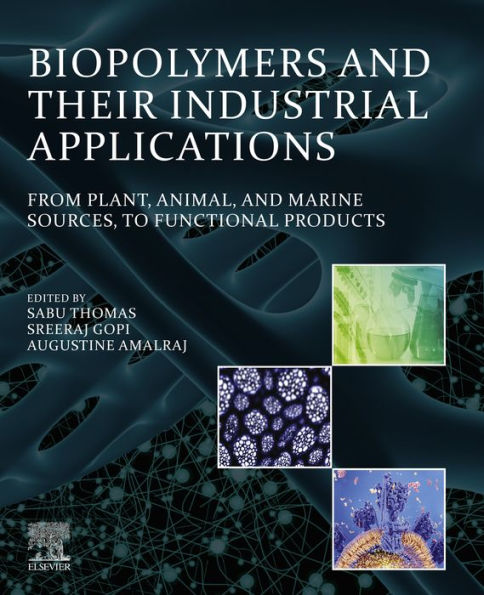Biopolymers and Their Industrial Applications: From Plant, Animal, and Marine Sources to Functional Products is a detailed guide to the use of biopolymers for advanced applications across a range of key industries. In terms of processing and cost, bio-based polymers are becoming increasingly viable for an ever-broadening range of novel industrial applications. The book begins with an overview of biopolymers, explaining resources, demands, sustainability, life cycle assessment (LCA) modeling and simulation, and classifications. Further in-depth chapters explore the latest techniques and methodologies for isolation and physicochemical characterization, materials selection, and processing for blends and composites.
Chapters 6 to 14 each focus on the preparation and applications of biopolymers in a specific industrial area, including food science and nutraceuticals, medicine and pharmaceuticals, textiles, cosmeceutical, packaging, adhesives and automotive, 3D printing, super capacitor and energy storage devices, and environmental applications. The final chapter compares and analyzes biopolymers alongside synthetic polymers, also offering valuable insight into social, economic, and environmental aspects. This is an essential resource for those seeking to understand, research, or utilize biopolymers in industrial applications. This includes researchers, scientists, and advanced students working in biopolymers, polymer science, polymer chemistry, biomaterials, materials science, nanotechnology, composites, and biotechnology. This is a highly valuable book for scientists, R&D professionals, designers, and engineers across multiple industries and disciplines, who are looking to utilize biopolymers for components and products.
- Introduces a broad range of industrial application areas, including food, medicine, textiles, cosmetics, packaging, automotive, 3D printing, energy, and more
- Offers an industry-oriented approach, addressing challenges and explaining the preparation and application of biopolymers for functional products and parts
- Considers important factors such as resources, classification, sustainability, and life cycle assessment (LCA) modeling and simulation
- Compares and analyzes biopolymers alongside synthetic polymers, also offering valuable insight into social, economic, and environmental aspects
Biopolymers and Their Industrial Applications: From Plant, Animal, and Marine Sources to Functional Products is a detailed guide to the use of biopolymers for advanced applications across a range of key industries. In terms of processing and cost, bio-based polymers are becoming increasingly viable for an ever-broadening range of novel industrial applications. The book begins with an overview of biopolymers, explaining resources, demands, sustainability, life cycle assessment (LCA) modeling and simulation, and classifications. Further in-depth chapters explore the latest techniques and methodologies for isolation and physicochemical characterization, materials selection, and processing for blends and composites.
Chapters 6 to 14 each focus on the preparation and applications of biopolymers in a specific industrial area, including food science and nutraceuticals, medicine and pharmaceuticals, textiles, cosmeceutical, packaging, adhesives and automotive, 3D printing, super capacitor and energy storage devices, and environmental applications. The final chapter compares and analyzes biopolymers alongside synthetic polymers, also offering valuable insight into social, economic, and environmental aspects. This is an essential resource for those seeking to understand, research, or utilize biopolymers in industrial applications. This includes researchers, scientists, and advanced students working in biopolymers, polymer science, polymer chemistry, biomaterials, materials science, nanotechnology, composites, and biotechnology. This is a highly valuable book for scientists, R&D professionals, designers, and engineers across multiple industries and disciplines, who are looking to utilize biopolymers for components and products.
- Introduces a broad range of industrial application areas, including food, medicine, textiles, cosmetics, packaging, automotive, 3D printing, energy, and more
- Offers an industry-oriented approach, addressing challenges and explaining the preparation and application of biopolymers for functional products and parts
- Considers important factors such as resources, classification, sustainability, and life cycle assessment (LCA) modeling and simulation
- Compares and analyzes biopolymers alongside synthetic polymers, also offering valuable insight into social, economic, and environmental aspects

Biopolymers and Their Industrial Applications: From Plant, Animal, and Marine Sources, to Functional Products
398
Biopolymers and Their Industrial Applications: From Plant, Animal, and Marine Sources, to Functional Products
398eBook
Related collections and offers

Product Details
| ISBN-13: | 9780128192597 |
|---|---|
| Publisher: | Elsevier Science |
| Publication date: | 10/31/2020 |
| Sold by: | Barnes & Noble |
| Format: | eBook |
| Pages: | 398 |
| File size: | 77 MB |
| Note: | This product may take a few minutes to download. |
